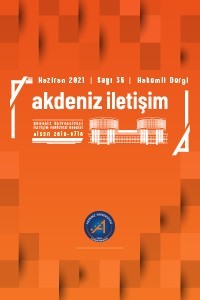31 Mart 2019 Mahallî İdareler Seçiminin Sabah Ve Sözcü Gazetelerindeki Sunumunun Karşılaştırmalı Olarak İncelenmesi
Bu makalede, 31 Mart 2019 günü gerçekleştirilen Mahalli İdareler seçimlerine ilişkin resmi olmayan ilk sonuçların Sabah ve Sözcü gazetelerinde hangi haber çerçevelemesiyle sunulduğu karşılaştırmalı olarak incelenmiştir. Her iki gazetenin 1 Nisan 2019’da yayınlanan nüshalarında seçim sonuçlarına ilişkin bütün haber metinleri içerik analizi tekniği ile incelenmiştir. Buna göre, her iki gazetenin farklı siyasî tercihlere ve ideolojik yönelimlere sahip oldukları görülmüştür. Bu nedenle haber çerçevelerinde siyasal ve ideolojik farklılıklar olduğu tespit edilmiştir. Sabah gazetesi resmi olarak seçim sonuçlarını iktidar partisinin bakış açısını meşrulaştıracak şekilde çerçevelerken; Sözcü gazetesi muhalefetin bakış açısını meşrulaştıran ve iktidarın politikalarını ve açıklamalarını eleştiren ideolojik bir haber çerçevesi kullanmıştır. Bu nedenle haberlerin açıklayıcı olmaktan ziyade yönlendirici olduğu görülmüştür. Gazeteler haber metinlerinde tarafsızlık ve denge iddia etmelerine rağmen, siyasi ve ideolojik tarafgirlik neticesinde partilerin imajları ideolojik olarak yapılandırılmaktadır. Bu en yalın halinde belli partilere taraf, diğerlerine karşı olmak şeklinde ortaya çıkmaktadır.
Anahtar Kelimeler:
31 Mart Mahalli İdareler Seçimi, Gazeteler, Haber Çerçeveleri
COMPARATIVE INVESTIGATION OF THE PRESENTATION OF LOCAL ADMINISTRATIVE ELECTIONS ON MARCH 31, 2019 in “SABAH” and “SOZCU” NEWSPAPERS
In this article, the comparative results of the informal preliminary results of Local Administrationelections held on March 31, 2019 in daily Sabah and Sözcü newspapers were analyzed. In the copies of both newspapers published on April 1, 2019, all news texts related to the election results were examined with content analysis technique. According to this, both newspapers had different political preferences and ideological orientations. Therefore, there are political and ideological differences in news frames. Sabah newspaper officially framed the election results to legitimize the viewpoint of the ruling party; Sözcü used an ideological news framework that justified the opposition’s point of view and criticized the policies and explanations of power. For this reason, it is seen that news is a guide rather than an explanatory. Despite the fact that newspapers claim neutrality and balance in their news texts, the images of parties are ideologically structured as a result of political and ideological bias. In the simplest form, certain newspapers appear to be adherent to some parties and against others
___
- Berelson B. (1952). Content analysis in communicationresearch Glencoe: FreePress
- Blumler, J. (1983). “Communication and Democracy: The Crisis Beyond and the Ferment Within”. Journal of Communication (Ferment in theField). Summer. 166-173.
- Entman, R.M. (1991). Framing U.S. coverage of international news: Contrasts in the narratives of the KAL and Iran airincidents. Journal of Communication, 41(4): 6–27.
- Galtung, J and Ruge, M.H. (1965). “Thestructure of foreignnews”. Journal of PeaceResearch, 1: 64–91.
- Gans, H. J. (1979). Deciding what’s news. New York: Vintage Books.
- Goffman, E. (1974). Frame analysis. Philadelphia: University of Pennsylvania Press
- Goffman, E. (1974a). Frame analysis: An Essay on The Organization of Experience.. New York: Harper&Row.
- Hall, S. (1999). “Kültür, Medya ve İdeolojik Etki”. Medya, İktidar, İdeoloji (içinde). Derleyen ve Çeviren: M. Küçük. Ankara: Ark. 199-243.
- Hall, S. Critcher, C., Jefferson, T., Clarke, J., Roberts, B. (1978). Policing the Crisis: Mugging, the State, and Law and Order. London: Red Globe.
- Kellner D. (1995). Media culture: Cultural studies, identify and politics between the modern and the postmodern. London Routledge.
- Merrill, J. C. And Odell, S. J. (1983). Philosophy and journalism. New York and London: Longman.
- Özer, Ömer (2000). “Haberde Egemen Söylemin Yeniden Üretilmesi”. Kültür ve İletişim (Kİ) Dergisi. Yaz. 3 (2). Ss.: 75-97.
- Scheufele, D. A. (1999). “Framing as a Theory of Media Effects”. Journal of Communication. 49 (4): 103-122.
- Shoemaker P., Reese, S. (1996). Mediating the message: Theories of influences on media content White Plains: Longman
- Tuchman, G. (1978). Making news: A study in theconstruction of reality. NewYork: FreePress.
- Van Dijk, T. A. (1999). “Söylemin Yapıları ve İktidarın Yapıları”. Medya, İktidar İdeoloji (içinde). Derleyen ve Çeviren: Mehmet Küçük. Ankara: Ark. 331-395.
- Van Dijk, T. A. (1988). News as Discourse. London: LawranceErlbaum.
- Woollacott, J. (1982). “Message andMeaning”. Culture, Society and the Media. M. Gurevitch, T. Bennett, J. Curran, J. Woollacott (Eds.). Londonand New York: Methuen.
- Yayın Aralığı: Yılda 3 Sayı
- Başlangıç: 2003
- Yayıncı: Akdeniz Üniversitesi
Sayıdaki Diğer Makaleler
Netflix’in İlk Türk Dizisi “Hakan Muhafiz” Üzerine Bir Alımlama Analizi
Sibel KARADUMAN, Elif Pınar ACİYAN
Alışıldık Tanımlamaların Gölgesinde İslami İnancın Batı Sineması’nda Yeniden Sunumu Taken 2
Mehmet Ali SEVİMLİ, Metin KASIM
Dijital İletişim Perspektifinden Destinasyon Markalaşması:Kuşadası’na yönelik bir inceleme
Anne-Bebek Kategorisi Kapsamında Markalama Stratejilerinde Nüfuz Pazarlamanın Önemi
Türkiye'de Ulusal Kanallarda Yayınlanan Dizi Fragmanlarında Şiddetin Sunumu
Seda SÜNBÜL OLGUNDENİZ, Pınar ÖZGÖKBEL BİLİS
Post-Yugoslav Sineması’nda Savaş Konulu Filmlerde Toplumsal Fantezi: “Düşman”
